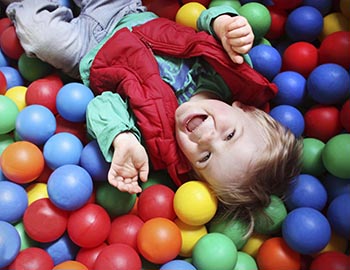With more than 15,000 nationwide, indoor playgrounds have become increasingly popular venues for play dates and birthday parties. They are like kiddie heaven, stocked with pillowy inflatables and candy-colored tubes, ball crawls, trampolines and more.
But, are they safe?
 Brian Geiger, Ed.D., a professor of health education in the Department of Human Studies University of Alabama at Birmingham (UAB), has assessed playground safety at schools and communities around Alabama. He said that while playing indoors may offer reduced threats of uninvited visitors, animals and motor vehicles, there are things parents should keep in mind to help keep their child free from injury.
Brian Geiger, Ed.D., a professor of health education in the Department of Human Studies University of Alabama at Birmingham (UAB), has assessed playground safety at schools and communities around Alabama. He said that while playing indoors may offer reduced threats of uninvited visitors, animals and motor vehicles, there are things parents should keep in mind to help keep their child free from injury.
Installation and maintenance guidelines for playgrounds are set by the American Society of Testing and Materials (ASTM) and the U.S. Consumer Product Safety Commission, and municipalities require initial inspections before granting a license to a new operator, but dangers still exist.
Geiger recently teamed up with Gary Edwards, Ph.D., chief executive officer of United Cerebral Palsy of Greater Birmingham, to share helpful tips for parents.
Give the area a scan. Take a good look at the play area to spot any potential dangers, and report any safety concerns to the operator. Geiger suggests bringing a safety checklist of things to avoid:
- Unanchored equipment that moves with use
- Pinch-points
- Exposed hardware
- Gaps in guard rails or between rungs of a ladder large enough for a head to fit through
- Open climbing structures and unsecured platforms
- Damaged fall surfaces
- Slides with a sharp angle of descent
- Plexiglas, rope and cargo webbing in need of repair
- Unsupervised ball pits
Have good, clean fun. “Germs may be transmitted through shared play equipment,” Geiger said. “Indoor playgrounds should be sanitized daily, more often in areas of high use.”
Ask the operator about their cleaning schedule, he said. In addition, since food and drinks are usually served at these places, be on the lookout for and report any spills or fall hazards.
If a child has the flu, diarrhea, other illnesses or exposed wounds, they should avoid contact with others.
Age appropriateness is important. Geiger said it is the parent’s responsibility to make sure that older and larger children are not playing “energetically” in the same area as toddlers and infants.
“Consider whether the space for physical activity is large enough to accommodate all children moving at the same time,” he said. “If you have young children, plan your visit on a weekday, perhaps in the morning.”
Ensure supervision. “Do not assume that someone else will supervise safe use of indoor playgrounds and party centers,” Geiger said. “Ask the operator about training and the number of play supervisors.”
Dress for safe play. Choose clothing that fits well without loose drawstrings, and tie shoe laces. Remove any necklaces, as well as items that can fall from their pockets.
Talk to children. “Teach children how to play safely,” Geiger said. “For example, take turns climbing ladders and going down the slide feet first.”
The U.S. Product Safety Commission and National Program for Playground Safety websites can also be helpful resources to parents concerned about playground safety.